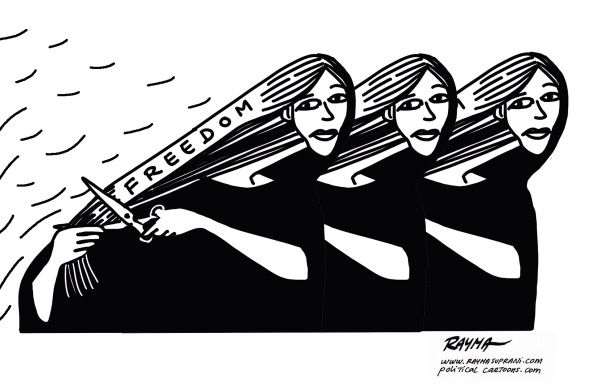Iran Rises Up
What's Next in This New Phase of the Revolution

The death of Mahsa Amini, while in the custody of Iran’s morality police, has sparked widespread demonstrations against the Islamic Republic of Iran. Whether or not these demonstrations will lead to a revolution remains unclear. However, by understanding the prerequisites of revolutions and analyzing how far the current movement has come to satisfy them, we may be able to assess how close the Iranian people are to leading a revolution.
The current revolutionary movement in Iran is in essence a continuation of the 1979 Revolution, which never experienced what the historian Crane Brinton refers to as its fourth phase. After a revolution, according to Brinton, first the liberals come to power, followed by conservatives, lunatics, and finally, moderates. The transition from the third to the fourth phase never occurred in Iran and as a result, Iranians lost hope that a systematic evolution could eventually address their political, economic, social, and cultural frustrations.
There are three conditions for a successful revolutionary movement, according to political scientist Chalmers Johnson, The first is the condition of non-alignment, caused by internal or external forces, between peoples’ expectations and what the society/environment offers them. For example, economic sanctions can hobble the state’s ability to satisfy peoples’ expectations, while access to the Internet, social media, and education can increase peoples’ expectations.
The second is the condition of instability, which is caused by a government’s inability to bring society back into alignment within a reasonable timeframe. Multiple recent popular uprisings in Iran demanding progressive change clearly reveal that the peoples’ expectations are not being met. Rather than offering more progressive socioeconomic and political changes, the government continued the same failed economic policies — responsible for reducing the GDP per capita from over $8,000 in 2012 to less than $3,000 in 2022 — and adopting even more restrictive social conditions through total control of school curriculum and media, as well as unleashing the security forces against government critics.
The third is a significant realignment of the loyalty of the security forces toward the revolutionaries. In this regard, time is on the side of the people. The longer demonstrations continue and the more diverse the protesters become, the harder it will get for the security forces — who have mothers, sisters, wives, and daughters — to use brute force on the people. In addition, a protracted uprising and a bloody response by the regime will cause rifts both within the government and in the religious community — as reported recently. This will, in turn, affect the cohesion of the security forces. The outcome of this movement may also be critically affected by the long-time rivalry between the regular army and Iran’s Revolutionary Guards.
Finally, a near unanimous global condemnation of the Islamic Republic’s treatment of its own people will have an impact on individuals within the security forces who may aspire to study or live abroad one day. This also will affect the financial ability of the government needed to keep the loyalty of the security forces. As it is, the government reportedly is employing hard-core prisoners to attack the demonstrators.
Iranian women have long been the leaders in this struggle. Even their small wins, like being able to wear nail polish or to show just a little bit of hair from their headscarves, were seen as hopeful signs that additional change could be peacefully gained. With the arrival of hardline president Ebrahim Raisi in 2021, however, the glimmer of hope faded. He quickly issued the “hijab and chastity” edict, emboldening the morality police. With the death of Mahsa, which resulted from showing a little more hair than the new government approved, all hope for progress under the current regime was lost.
Though the protests were sparked by the issue of a woman’s right to choose how to dress, the aspirations behind the uprisings go far beyond that. Iranians are fighting against the socioeconomic and political pressures that have steadily worsened. Mahsa Amini’s death was merely the spark that ignited the fire.
The beginning stages of a revolutionary movement are often spontaneous and disorganized. It’s the movement’s ideology that unites different groups seeking to eliminate an oppressive system. Contrasting the 1979 Revolution’s main ideology of “Down with the Shah,” the present movement’s ideology is “Woman, Life, Liberty,” which is so inclusive that women, men, young, and old from all walks of life can all unite under this banner.
While it’s impossible to predict when a movement will lead to a successful breakdown of the system, it’s clear that the current movement has satisfied at least two of the three conditions of a successful revolution. It’s also important to remember that revolution is an ongoing process in which each major challenge creates a crack that can eventually topple the whole structure.
In contrast to 1979, the people are now specific as to what form of regime they want: a secular democratic government. Hopefully, leaders will emerge soon to shepherd them throughout this journey, while mitigating human loss and bloodshed.
A petition urging the international community to speak out against the death penalty for protesters can be found here.
Farzeen Nasri teaches political science and economics at Ventura College and Global Studies at the Graduate School of Global Studies at the University of Salamanca, Spain.



